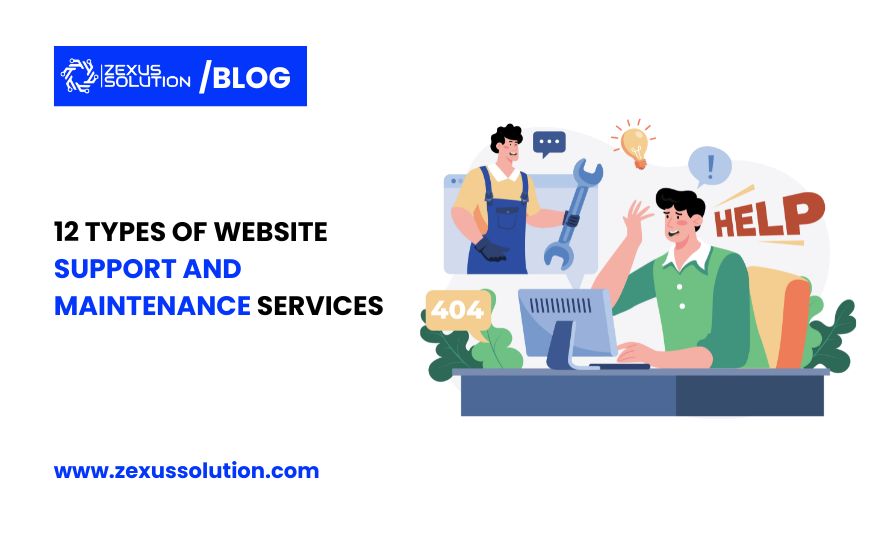Table of Contents
In today’s era, a functioning website is essential to sustain any business. Whether you have a start-up or a huge enterprise, clients usually judge your business through websites.
Even if a website is well-developed and designed, it needs consistent maintenance. Without maintenance, a website is like a car without fuel—eventually, it stops running smoothly and becomes unreliable.
Web application maintenance services make sure that your web familiarity is always interactive, safe, and well-kept. Websites are like any other software or hardware. They need periodic updates and checks to remain functional.
When you maintain your site, you are not only maintaining its usability but also its performance in search engines. Search engines look for and rank such sites high since they cause no delays and risks and are regularly updated so that potential clients can find you easily.
Understanding Website Support and Maintenance:

The importance of website maintenance can be understood by any business that seeks to have a significant online presence. Web app maintenance services include several such activities which help to ensure the effective running of a website or an application including simple updates as well as more complex ones like performance tuning or installing security fixes. Embracing the latest trends in web app maintenance such as automation, proactive monitoring of systems, and AI-based improvement strategies could enhance the competitiveness of your company in the market.
In the context of what’s next in web app maintenance, the emphasis of attention seeks to turn to more intelligent and more effective solutions. Thanks to AI and predictive analytics, it is now possible to efficiently predict and avoid problems before they even become issues, thus improving the user experience and expediting processes. Adhering to web app maintenance tips including things like enabling auto backup of the application’s data, monitoring user response to the application, and conducting routine checks for compatibility ensures that your application runs in optimal conditions and remains appealing to its users.
Clinging on to application maintenance best practices on a regular basis shields your application from untimely death and assures its consistent performance. This also means ensuring those load times are acceptable, fixing dead links, and ensuring that the systems in place to protect sensitive information are up to date. Hence, when you wear the hat of a web app maintenance service provider, you are not only taking care of that digital asset but also enhancing the day-to-day experience of your users.
12 Types of Website Support and Maintenance Services:
In this ever-evolving digital era, it is imperative to have an updated website to outdo your competitors and satisfy your customers. It does not matter whether you are running a small-scale company or a multinational corporation, the quality of a website plays a great part in the realized success. Working with the best website maintenance companies ensures that the website is up-to-date and performance optimized as well as fully secured. Having a well-organized website maintenance checklist can help streamline tasks, from updating content to enhancing security features, ensuring no detail is overlooked.
The concept of web platform maintenance assumes only regular updates of the site; this is not true – it is also a systemic enhancement of the customer experience, the increasing of the speed of the website, and its compliance with the current trends. If these basic maintenance services are disregarded, for instance, there will be a loss of visitors, a tarnished image, and chances of appearing on any search engine will be slim.
The following 12 types of website support and maintenance services are key to ensuring your site remains in top form.
1. Website Backup Support:
Every now and then taking a complete backup of the website becomes important because all the data relevant to the website remains intact somewhere and can be used in the event of a glaze vandalism, loss of data due to technological breakdown, or a cyber attack. Backups can include everything from entire site disk images to just databases so that no data is lost.

Automated solutions to backup systems allow businesses to prevent data loss and any storage subsystem outages for that matter during the operation of their resource. Moreover, firms are adopting new technologies such as AI and predictive maintenance strategy now which also helps in improving the process.
When the site is being backed up, algorithms powered by AI can also evaluate the amount of traffic on the site. This allows for the scheduling of site backups in good time instead of when the site is anticipating problems like heavy user activity or glitches due to conflicting programs.
2. Search Engine Optimization (SEO):
Out of all the marketing strategies today, SEO is one of the most effective instruments, as it helps to keep the website competitive and visible in the online world. SEO is the practice of improving rankings on search engine results from pages by making the site’s content, keywords, metadata, and general structure better. Content updating and incorporation of relevant keywords by the changing trends of what clients look for during the period is also key in ensuring that visibility is maintained at above-average levels. Consistently refining one’s website for optimal performance is important, especially given that search engines are always working to upgrade their algorithms.
For businesses offering website maintenance services, SEO becomes an essential part of the offering. This way, knowing exactly how to sell website maintenance is also about implying to the client the need for persistence of implementation of SEO activities over time. Quite a few businesses will probably overlook that SEO is not finished after one has ‘done’ it – fundamentals are never over. The advantages of consistent SEO Improvements may thus be illustrated for business purposes, where it is understood that increased Organic SEO will in turn develop the online business presence and enhance marketing sales hence the need for the business.
3. Website Analytics, data, or statistics
Analyzing website metrics is fundamental to ensuring a positive online presence. Data such as the number of hits, characteristics of the users, abandonment rates, and purchase rates, could help website administrators understand visitors’ tendencies. This aids in strategizing on the effective ways to enhance the content, arrangement, and usability of the website.
An analysis of this curve helps to understand what’s working and what’s not, and which specific aspects of the design may require further development. For instance, an analysis of the web page bounce rate shows a certain page has a high number of visitors who leave after a few seconds, this is a clear signal that the page’s content or layout requires changes or upgrades to attract and keep visitors.
Website maintenance plans that incorporate efficient data tracking and evaluations often bear positive results over the years. Such plans include the analysis of the website usage statistics on a monthly basis which enables companies to implement changes in the strategies and contents as per the current situation. The methodology used in this case is very effective because it guarantees that the site is improving concerning the behaviors of the users and not from mere speculation or stale information.
4. Website Software Update
The preservation and proper functioning of the various software components of a website, including the content management system (CMS), significantly depends on their regular updates. Typically, users expect to enjoy out-of-the-box releases of applications or websites that include full functionality and do not require any additional bug fixes. Software update has a lot of advantages, for instance, it provides fixes for errors in the software, improve features, and provides added security to the software. If a system has applications that are out of date and therefore incompatible with other systems, there is a risk that the system itself may not work or may work in a very limited capacity. Even worse, old programs have been known to come with security weaknesses that are prone to being taken advantage of by hackers, thereby endangering the site and the data of the users. This preparation minimizes the above risks, guarantees that the operation of the system will be smooth, and the system will meet all the contemporary security requirements.
The process of upgrading software does not only entail correcting faults but also process optimization. Most application upgrades are designed with features that enhance the speed of the application and the user interface with the technology as well as new technology applications. This makes it a critical component of a web maintenance contract, ensuring that all aspects of your website are functioning as they should. Businesses that include software updates as part of their maintenance agreement can be assured that their website will work properly, and remain safe and relevant to the market’s needs at all times.
5. Routine Content updates (new and existent):
Updating the content promptly is the key to maintaining an interesting website. Search engines tend to prefer sites that have up-to-date and relevant content, which is why adding fresh articles, blog posts, product pages, and so on, consistently can improve the SEO rankings of the site dramatically. Apart from that, the other option involves the enhancement of the already existing content – whether through simple edits, additional information, or complete rewrites – ensuring that the visitors get the most up-to-date content on the page.
New material is useful for SEO but it is equally important in retaining the user’s attention. Such users are the ones who will return to this particular website because it offers relevant high-quality content regularly. By offering routine content updates, web maintenance packages can include everything from text revisions to the addition of new media, ensuring that the website continues to provide a rich, relevant experience. Whether it is correcting the seasonal promotional offers, alterations of old blogs, resourcing information or adding new services to the site, changing or improving uploaded content remains crucial in keeping the target audiences and search engines satisfied.
6. Website Security Support:
The development and maintenance of a website would not be complete without considering its security. As cyber threats become more sophisticated, the best practice is to implement security measures such as the use of SSL certificates, regular malware scans, and the installation of firewalls to minimize the associated risks. These measures not only shield the owner’s website but also ensure that the users do not fall victim to data theft, hacking, and other online vices. Security assessments and upgrades on a website are important at the same time since they help to fix issues that may have been discovered before they can be taken advantage of.
Such maintenance plans for a website usually cover certain aspects of security regularly, for example, conducting routine checks for malware and testing for possible weaknesses. These initiatives ensure that your site has adequate protection technologies against any form of intrusion. This incorporates actions such as carrying out reinstatement of SSLs, enhancing password protection on websites, adding safe e-commerce gateways, and so on which ensures that the clientele’s confidence is enhanced while their data is kept safe. Moreover, the regular practice of installing security updates and software patches significantly lowers the chances of an attack on the website, thus ensuring its security and functionality.
7. CMS Update:
Although Content Management Systems (CMS), such as WordPress, Joomla, and Drupal, are the core of most websites because they are relatively easy and simple to use, and provide a lot of flexibility. This, however, doesn’t imply that they are fool-proof. Like all other forms of Computer applications, CMS solutions also require updates periodically for continued operation, safety, and integration with emerging technologies. These changes most often contain new aspects that are meant to improve the experience of the user such as performance enhancement and addition of new elements to the system. If you decide to use a particular CMS and never bother to update it, you run the risk of the system becoming obsolete with diminished functionality, security flaws, and consistency problems with installed plugins or skin designs.
Concerning the question of what website maintenance includes, as much as CMS updates are beneficial and progressive, they should also be presented as an aspect of any maintenance technique. These updates remove the lag that the CMS is experiencing and bring it right back up to the web standards, security, and practices common at the time. There will also be updates that provide more efficient site management tools and better overall user experiences. Therefore, the inclusion of CMS Update services in a Web Maintenance Package enables organizations to maintain and manage their websites efficiently and effectively without in-house capabilities.
8. Site Functionality and Tweaks
When considering the various aspects that comprise a good user experience, site functionality emerges as a premise. Regular testing and tweaks become a requirement to make sure that all the interactive elements in the website including buttons, forms, navigational menus, and so on are working as they should be. Such factors as simple and responsive design contribute to user satisfaction and willingness to interact with the content. Routine checks help in spotting deterioration aspects such as broken links, poor loading pages, inactive forms, etc which are bound to lower the efficiency of the website.
It is often asked what a website manager changes for maintenance. There are several actions included like small yet impactful tweaks to improve usability and accessibility. On analytics, these tweaks help ease out the flow of the site to the users thereby lessening bounce rate and helping with conversions. For instance, site navigation can be enhanced or content arrangement altered according to users’ suggestions for a more user-friendly and accessible site thus enabling better usability.
9. Improving Website Speed:
A slow-loading website is one of the fastest ways to lose its visitors, hence improving website speed is crucial. With the advancing technology, nearly every user comes to expect a website to load within seconds. Any delays often lead to high bounce rates. For these reasons, regularly optimizing the website speed becomes important in enhancing the users’ interest and retention. Some of the main strategies are image optimization, content delivery networks, browser caching, minification of JavaScript and CSS files, and reduction of HTTP requests.
Speed optimization forms a part of most web maintenance packages, and in such instances, the specialists regularly check and improve the site’s loading speed. Such improvements help in resizing images, organizing the code, and optimizing the utilization of third-party resources. A well-designed and developed website that is fast and responsive increases users’ satisfaction and in turn, ranking is improved as search engines’ algorithms aim at rewarding quick-loading webpages.
10. Monitoring and Improvement of Performance:
Systematic performance monitoring is of utmost importance since it helps in identifying possible problems before they blow out of proportion. All these instances can affect a website in many ways, whether it is due to one or more server issues, high traffic levels, or weak coding practices. Advanced tools such as artificial intelligence predictive maintenance algorithms are being incorporated more and more into web platform maintenance. These tools also illustrate site performance trends and help prevent such complaints as slowness or total server outages by making it possible to resolve problems before they manifest.
It is the constant monitoring that helps in the early detection of any dips in performance and this allows the swift remediation of the situation by the concerned parties. It’s also about maintaining the web in a healthy and scalable manner considering traffic fluctuations. Maintenance predictive tools can also indicate the time frame after which certain system modifications or enhancements will be advisable so that performance improvement does not stop.
11. Plugins and Themes Update:
The safety and performance of any website is compromised with the use of outdated plugins and themes. That is why whenever developers create changes on plugins and themes, solutions to problems, improvements to existing performance, and fixing existing security weaknesses are most likely included.
Not updating them could expose the website to hackers or could render certain conflicts with other applications. Most of the website’s maintenance packages offered by digital agencies include specific intervals at which new versions of these plugins and themes are installed to enhance the safety, usability, and relevance of the website.
12. Repairs and Fixes:
There are times when a website displays problems, and such issues need to be solved immediately to avoid inconveniences to the website users. Maintenance and updates can range from minor adjustments like changing incorrect images or correcting image placement to more involved processes such as fixing internal server errors or debugging custom scripts.
When asking how much website maintenance costs, it’s important to consider the scope of repairs. Simply put, smaller damages are often included in basic web upkeep plans, however, more complicated damages that require fixing some databases or dealing with a hack may be managed separately and more time considered.
In the present age of the internet, it is not enough to just create a website, there is a need for its maintenance as well. This consistent attention to the site makes sure that it is secure, quick, and pleasant to the users thus aiding the growth of the business and its dependability. For organizations deliberating on their options, knowing what web app maintenance services are, can enable them to appreciate the reason why such services are important both in meeting the day-to-day activities and even the strategic objectives of the organization. If you are looking to diversify your service offerings, you must understand how to sell website maintenance services to your clients so that you can communicate the need for such services, making them see you as a needful ally rather than a call.
Having a monthly website maintenance plan and its implementation helps to avoid pitfalls like performance outages, as defining dates for updates, security routines, or performance checks becomes possible. A more tactical and developed website maintenance schedule will ensure that you are always one step ahead, with your online activities active, adjustable, and prepared for growth.



Add a Comment